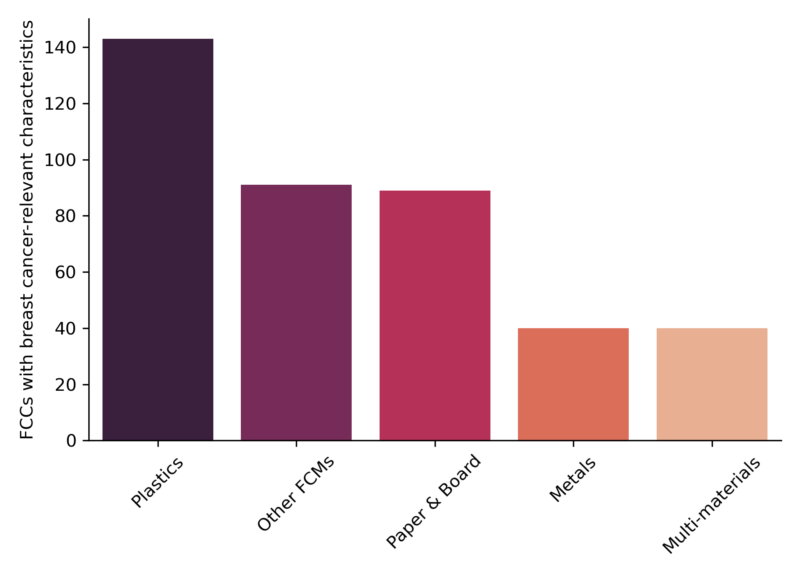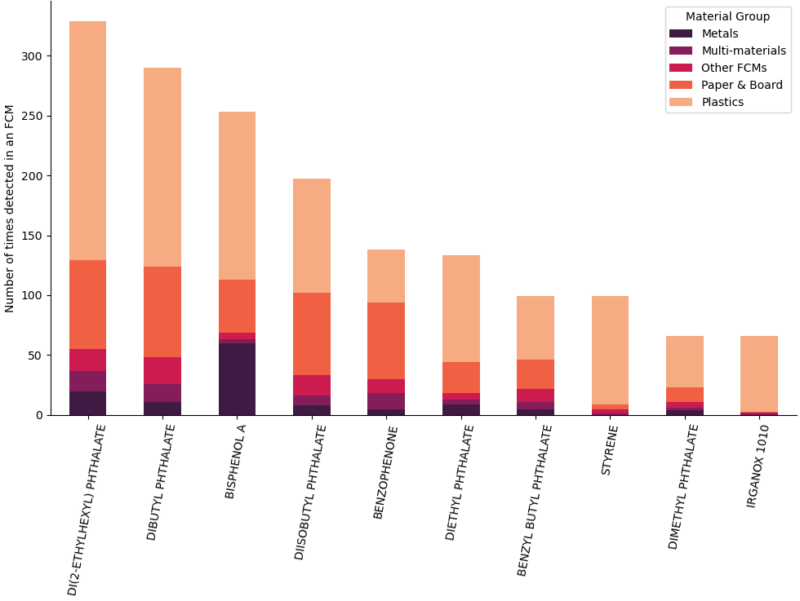In an article published on January 10, 2024, in Environmental Health Perspectives, Jennifer E. Kay and co-authors from the Silent Spring Institute and the University of California, Berkeley published a list they developed of over 900 chemicals with evidence that they may increase breast cancer risk.
The researchers reviewed information from “authoritative databases,” including International Agency for Research on Cancer (IARC) Monographs and the US Environmental Protection Agency’s (EPA) ToxCast to find which chemicals have been found to induce mammary tumors in rodents. Then they looked at multiple aspects of endocrine activity and genotoxicity of these chemicals to assess the key characteristics of rodent mammary carcinogens, and to identify other chemicals that exhibit these effects and may, therefore, increase breast cancer risk (FPF reported also here).
In all, Kay and co-authors found 921 “breast cancer relevant exposures.” These “exposures” are substances that are known to either directly contribute to breast cancer development in rodents (in vivo evidence) or share key endocrine disrupting or genotoxic characteristics (mechanistic evidence) with those carcinogens. This is a significant expansion from when the list was first developed in 2007.
Of the 921 breast cancer-relevant chemicals found by Kay and co-authors, 189 have been measured in food contact articles according to the Food Packaging Forum’s database on migrating and extractable food contact chemicals (FCCmigex). Migration experiments more closely resemble real-use situations but even when limiting FCCmigex results to migration, 121 breast cancer relevant chemicals have still been detected.
Three-quarters of the breast cancer relevant food contact chemicals (FCCs) were detected in food contact articles made with plastic, but all material groups except glass* contained some of the chemicals (see Figure 1. *note: some of these chemicals may be in metal closures of glass containers).

Figure 1. The number of breast cancer relevant substances from Kay et al.’s list that have been detected in migration or extraction studies of five food contact material groups.
In the study, the authors call for a significant improvement of hazard identification methodologies related to chemical use in everyday products. This includes enhanced assessments focusing on the effects of these compounds on the mammary gland, the development of assays for a broader range of chemicals, and a more comprehensive approach to chemical testing.
FPF’s Chief Scientific Officer, Jane Muncke, together with 20 other scientists recently published a vision for safer food contact materials that discusses some of the same concerns (FPF reported). Muncke et al. developed the six clusters of disease concept, which highlights prevalent and increasingly concerning non-communicable diseases linked to chemical exposures: cancers, cardiovascular diseases, as well as reproductive, brain-related, immunological, and metabolic disorders. The vision proposes a novel approach for testing FCCs that includes assessing the health impacts of FCCs and real-life mixtures with respect to the most prevalent non-communicable diseases in the human population.
The ten most-often-detected breast cancer relevant chemicals in food contact articles are (see also Figure 2):
- Di(2-ethylhexyl) phthalate (CAS 117-81-7)
- Dibutyl phthalate (CAS 84-74-2)
- Bisphenol A (CAS 80-05-7)
- Diisobutyl phthalate (CAS 84-69-5)
- Benzophenone (CAS 119-61-9)
- Diethyl phthalate (CAS 84-66-2)
- Benzyl butyl phthalate (CAS 85-68-7)
- Styrene (CAS 100-42-5)
- Dimethyl phthalate (CAS 131-11-3)
- Irganox 1010 (CAS 6683-19-8)

Figure 2. The ten most studied food contact chemicals included in Kay et al.’s list of breast cancer relevant substances. Bars represent the number of times it has been detected in migration or extraction experiments from a food contact article, color represents the material of the article.
Many of these breast cancer-relevant FCCs have been under scrutiny at multiple regulatory jurisdictions in recent months and years. The European Food Safety Authority (EFSA) in 2023 lowered the tolerable daily intake for bisphenol A (BPA) by a factor of 20,000 (FPF reported). The US Food and Drug Administration is expected to make a decision on BPA this year (FPF reported) while Washington State banned bisphenol-based can liners entirely and has a plan to reduce citizen exposure to phthalates (FPF reported). The European Chemicals Agency recently expanded its substances of very high concern (SVHC) listing for dibutyl phthalate (FPF reported) and has suggested regulating phthalates as a group due to reprotoxic and endocrine disrupting properties (FPF reported). In Europe there is a specific migration limit for phthalates in platic FCMs, but EFSA is currently conducting preparatory work for the re-evaluation of phthalates, structurally similar substances, and replacement substances that are potentially used as plasticizers in food contact materials (FPF reported).
This concern for chemical testing and regulation is reflected by Kay et al. who “argue that many of these [chemicals] should not be considered low hazard without investigating their ability to affect the breast, and chemicals with the strongest evidence can be targeted for exposure reduction.”
Reference
Kay, Jennifer E., et al. (2024). “Application of the key characteristics framework to identify potential breast carcinogens using publicly available in vivo, in vitro, and in silico data.” Environmental Health Perspectives. DOI 10.1289/EHP13233
Read more
Jones, R.R. and A.J. White. 2024. “New Motivations and Future Directions for Investigating Environmental Risk Factors for Breast Cancer.” Environmental Health Perspectives. DOI: 10.1289/EHP13777
Liza Gross (January 10, 2024). “More Than 900 Widely Used Chemicals May Increase Breast Cancer Risk.” Inside Climate News.
Silent Spring Institute (January 10, 2024). “More than 900 chemicals, many found in consumer products and the environment, display breast-cancer causing traits.”
